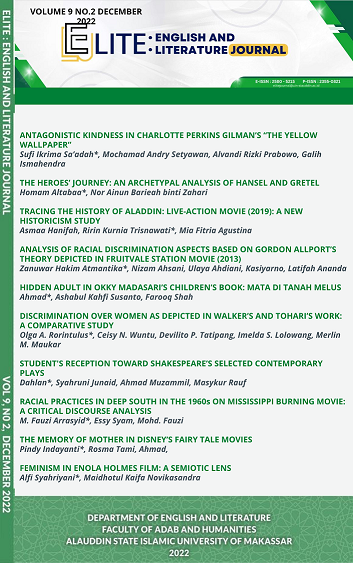THE HEROES’ JOURNEY: AN ARCHETYPAL ANALYSIS OF HANSEL AND GRETEL
Abstrak
Ada banyak dongeng dalam tradisi Eropa, dan terutama dalam koleksi Grimm, yang menggunakan banyak tema pola dasar, karakter, dan motif. Ini berlaku untuk kisah populer, Hansel dan Gretel. Pemeriksaan arketipe bisa menjadi tugas yang melelahkan mengingat signifikansi psikologis dan budayanya yang kaya dan penggunaannya yang meluas di antara peradaban dan genre yang tampaknya berbeda. Oleh karena itu, penelitian ini menganalisis penggunaan arketipe dalam koleksi Grimm - melalui contoh Hansel dan Gretel - untuk mengeksplorasi signifikansi mereka sepenuhnya karena arketipe ini berpotensi menjadi alasan di balik popularitas abadi cerita ini dan koleksi secara umum. Metodologi penelitian ini didasarkan pada tahapan pola dasar dari perjalanan atau pencarian pahlawan sebagaimana diuraikan oleh Joseph Campbell dalam karya seminalnya, The Hero with a Thousand Faces. Studi ini menyimpulkan bahwa Hansel dan Gretel dengan terampil menggunakan banyak elemen pola dasar seperti wanita jahat, keteraturan versus kekacauan, ambang pintu dan pembantu, dan penipu dan penyihir dalam kerangka pola dasar perjalanan seorang pahlawan untuk memungkinkan protagonisnya mencapai psikologis dan moral. kedewasaan, dan imbalan materi. Melalui beberapa halamannya, Hansel dan Gretel menawarkan kepada pembaca pelajaran moral yang kaya tentang keberanian, kemunduran, kelihaian, kesetiaan, kejahatan, kasih sayang, dan takdir melalui penggunaan pola dasar perjalanan dan berbagai elemennya.
Kata kunci: Arketipe, dongeng, Hansel dan Gretel, perjalanan pahlawan
##plugins.generic.usageStats.downloads##
Referensi
Anderson, G. (2000). Fairytale in the ancient world. Routledge.
Audi, R. (1999). Cambridge dictionary of philosophy. Cambridge University Press.
Baldick, C. (2001). The concise Oxford dictionary of literary terms. Oxford University Press.
Bettelheim, B. (2010). The uses of enchantment: The meaning and importance of fairy tales. Vintage Books.
Brunel, P. (1996). Companion to literary myths, heroes, and Archetypes. Routledge.
Campbell, J. (2004). Heroes with a thousand faces. Princeton University Press.
Chirila, A. (2010). Archetypal Criticism. In M. Ryan (Ed). The encyclopedia of literary and cultural theory (1st ed., 1, pp. 41-51). Wiley-Blackwell.
Cirlot, J. E. (2001). A dictionary of symbols (e-book ed.). Taylor & Francis e-Library.
Cotterell, A. (2006). Encyclopedia of mythology. Hermes House.
Cuddon, J. A. (1999). The Penguin Dictionary of literary terms and literary theory. Penguin Books.
Denecke, L. (n.d.). Brothers Grimm | Biography, Stories, & Works. Encyclopedia Britannica. https://www.britannica.com/biography/Brothers-Grimm
Doig, A. (2022). This mortal coil: A history of death. Bloomsbury.
English Standard Version Bible. (2001). ESV Online. https://esv.literalword.com/
Ferber, M. (1999). A dictionary of literary symbols. Cambridge University Press.
Frye, N. (1957). Anatomy of criticism. Princeton University Press.
Gatricya, R. (2014). The archetypes of hero and hero’s journey in five Grimm’s fairy tales. Yogyakarta State University.
Haase, D. (2008). The Greenwood encyclopedia of folktales and fairy tale. Greenwood Press.
Heidi, S [Tedx Talk]. (2018, May 24). Myths, Folklore & Legends: We Still Need Our Fairy Tales | Heidi Shamsuddin | TEDxUniversityofMalaya [Video]. YouTube. https://www.youtube.com/watch?v=5HlBwSYjUPI
Jung, C. G. (2004). Four archetypes: Mother, rebirth, spirit, trickster. Taylor & Francis e-Library.
Mohamad A. Q., & Rosli, T. (2000). Dictionary of literary terms revised edition. Prentice Hall.
Murphy, G. R. (2000). The owl, the raven, and the dove: the religious meaning of the Grimms' magic fairy tales. Oxford university Press.
O Grada, C. (2009). Famine: A short history. Princeton University Press.
Payne, M., & Barbera J. R. (2010). A dictionary of cultural and critical theory second edition. Wiley-Blackwell.
Peterson, J. B. (2002). Maps of meaning. Routledge.
Quinn, E. (2006). A dictionary of literary and thematic terms. Facts on File.
Serman, J. (2008). Storytelling: An encyclopedia of mythology and folklore. Sharpe Reference.
Silva, R. S. (2012). Fairy tales and moral value: A corpus-based approach. BELT Journal, 3(1), pp. 133-145. https://revistaseletronicas.pucrs.br/ojs/index.php/belt/article/view/10326
Sorea, D. (2018). The role of fairy tales in the self-realization process. In A. Repanovici, M. Koukourakis, T. Khecyoyan (Eds), Book power in communication. Trivent Publishing.
Tatar, M. (2015). The Cambridge companion of fairy tales. Cambridge University Press.
Tatar, M. (2019). The hard facts on Grimms fairy tales expanded edition. Princeton University Press.
Teverson, A. (2013). Fairy tale. Routledge.
Teverson, A. (2019). The fairy tale world. Routledge.
VandenBos, G. R. (2015). APA dictionary of psychology. American Psychological Association.
Zipes, J. (2000). The Oxford companion to fairy tales United States. Oxford University Press.
Zipes, J. (2012). A fairy tale is more than just a fairy tale, Book 2.0, 2(1), pp. 113-120. doi: 10.1386/btwo.2.1-2.113_1
##submission.copyrightStatement##
##submission.license.cc.by-nc-sa4.footer##Once an article was published in the journal, the author(s) are:
granted to the journal right licensed under Creative Commons License Attribution that allows others to share the work with an acknowledgement of the work's authorship.
permitted to publish their work online in third parties as it can lead wider dissemination of the work.
continue to be the copyright owner and allow the journal to publish the article with the CC BY-NC-SA 4.0 license
receiving a DOI (Digital Object Identifier) of the work.


